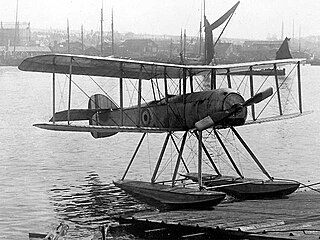Related Research Articles
The AD Scout was designed by Harris Booth of the British Admiralty's Air Department as a fighter aircraft to defend Britain from Zeppelin bombers during World War I.

The Sopwith Tabloid and Sopwith Schneider (floatplane) were British biplanes, originally designed as sports aircraft and later adapted for military use. They were among the first successful types to be built by the Sopwith Aviation Company. The "Tabloid", so named because of its small size, caused a sensation when it made its first public appearance.

The Blackburn TB was a long-range twin-engined anti-Zeppelin seaplane. It was Blackburn's first multi-engine aircraft to fly.

The Wight Baby was a British single-seat seaplane fighter produced by John Samuel White & Company Limited. Only three prototype aircraft were built.
The Pemberton-Billing P.B.25 was a First World War British single-seat scout aircraft built by Pemberton-Billing Limited, later Supermarine Aviation Works Limited.
The Sopwith Two-Seat Scout was a 1910s British biplane Anti-Zeppelin scout biplane designed and built for the Admiralty by the Sopwith Aviation Company. It was nicknamed the Spinning Jenny due to a tendency to enter a spin.

The Grigorovich M-11 was a Russian single-seat fighter flying boat designed by Dmitry Pavlovich Grigorovich and built by Shchetinin
The Engels MI was a Russian floatplane/fighter developed in 1916. It was a parasol cantilever flying boat with a V-Section hull, and downswept wingtips incorporating flotation chambers.

The Morane-Saulnier AI was a French parasol-wing fighter aircraft produced by Morane-Saulnier during World War I.

The Vickers F.B.12 was a biplane pusher fighter aircraft developed during World War I by Vickers Limited. The failure of the engine for which it was designed, and the obsolescence of the pusher configuration, resulted in its remaining an experimental type only.
The Morane-Saulnier AF, also known as the Morane-Saulnier Type AF and the MoS 28 was a French First World War single-seat biplane fighter prototype from 1917.

The Blackburn Triplane was a single-engine pusher single-seater, designed specifically to attack Zeppelins. It flew in 1917, but was not successful.
The Westland N.1B was a prototype British single-engined floatplane fighter aircraft of the First World War. The first aircraft to be designed by Westland Aircraft, it was a single-engined tractor biplane. Despite good performance, only two aircraft were built, the Royal Naval Air Service operating landplane fighters from ships instead.
The Sage Type 2 was a prototype British two-seat fighter aircraft of the First World War. A single-engined biplane with an enclosed cabin for its crew, only a single example was built, as more advanced aircraft became available.

The Vickers E.F.B.7 was a prototype British fighter aircraft of the First World War. A twin-engined biplane, the E.F.B.7 was unsuccessful, only one being built.

The Vickers E.S.1 was an early British Fighter aircraft of the First World War. A single-seat biplane, only three E.S.1s were built, although at least one was used by a home defence squadron of the Royal Flying Corps.
The Port Victoria P.V.9 was a British single-seat biplane floatplane fighter of the First World War. Although claimed to be the best aircraft of its type yet to be tested, only a single prototype was built.
The Port Victoria P.V.4 was a prototype two-seat reconnaissance floatplane of the First World War. The P.V.4 was a small single engined pusher biplane. It was unsuccessful as the engine it was designed around was a failure and alternatives were unsuitable, only one aircraft being built.
The Port Victoria P.V.5 was a British single-engined floatplane fighter aircraft of the First World War. A single example was built and flown at the Royal Naval Air Service's Port Victoria Marine Experimental Aircraft Depot on the Isle of Grain in 1917. Despite demonstrating good manoeuvrability and handling, no production followed, with the Royal Naval Air Service instead using landplanes for the fighter role.
The SPAD S.XV was a single-seat fighter designed and built in France and offered to fulfil a 1918 C1 specification.
References
- Bruce, J.M. "The Sopwith Tabloid,Schneider and Baby: Historic Military Aircraft No.17 Part IV". Flight , 29 November 1957. pp. 845–848.
- Collyer, David. "Babies Kittens and Griffons". Air Enthusiast , Number 43, 1991. Stamford, UK:Key Publishing. ISSN 0143-5450. pp. 50–55.
- Mason, Francis K. The British Fighter since 1912. Annapolis, Maryland:Naval Institute Press, 1992. ISBN 1-55750-082-7.